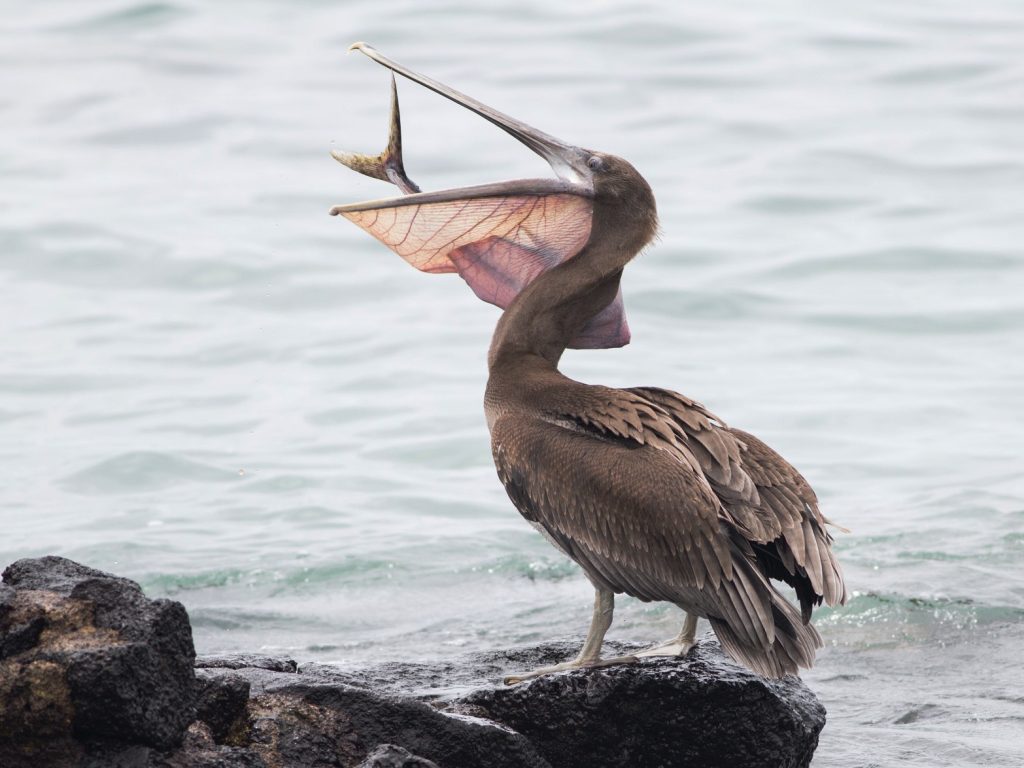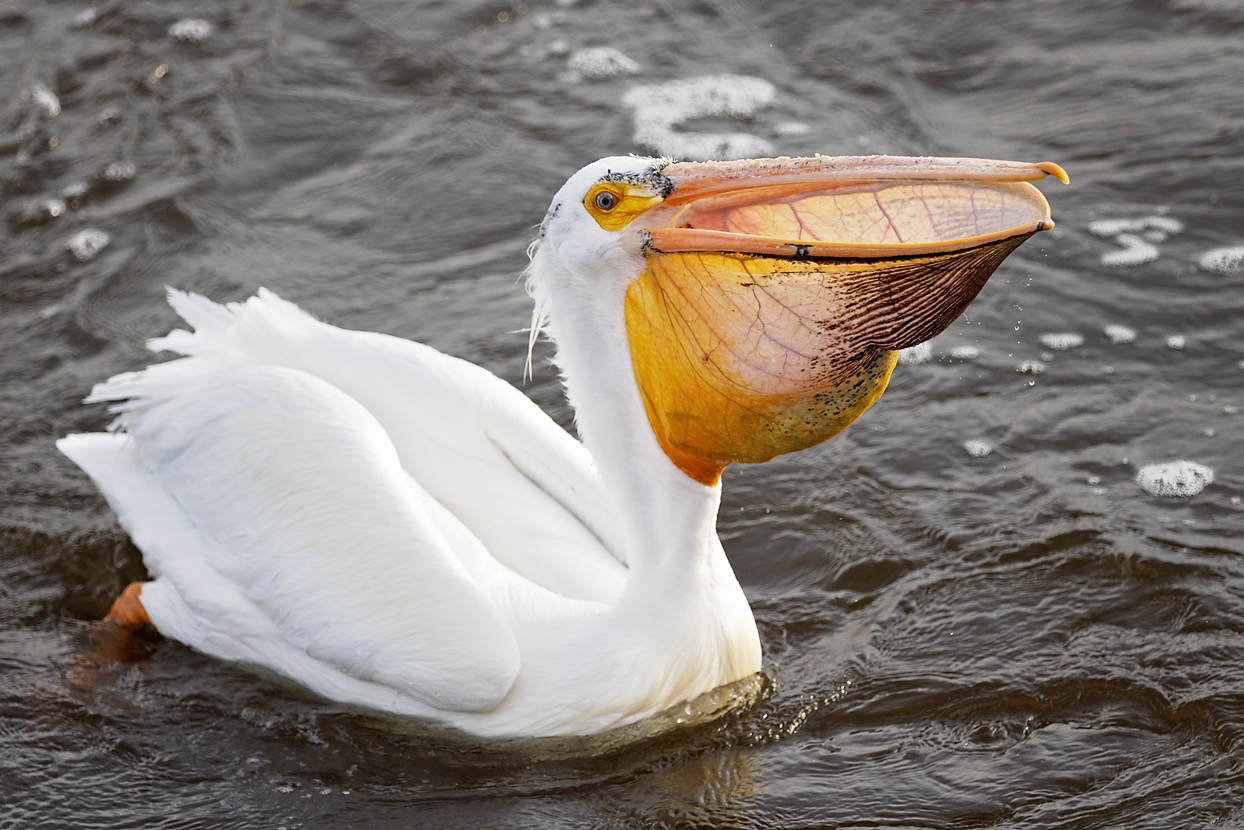In South Carolina, you can spot both species of Pelican native to North America. These include the American White Pelican and the Brown Pelican.
Throughout the year, Brown Pelicans can be observed in this region, while the American White Pelicans are known to visit during the winter months.
Pelicans, known for their massive bills, throat pouches, and feet, rank among the largest birds worldwide. Surprisingly, despite their size, they are relatively lightweight. This is due to the presence of air pockets within their bones and skin, aiding in flotation, while their elongated wings facilitate graceful flight.
Globally, there are eight distinct pelican species, with two residing in North America—the American White Pelican and the Brown Pelicans.
During breeding season, pelicans undergo vibrant transformations, with their facial skin, throats, and bills adopting more vivid colors, and some even growing additional structures on their bills.
Pelicans breed in colonies consisting of up to 50,000 individuals. Depending on the species, they may either nest on the ground or in trees. After spending approximately 25 days in the nest, the young pelicans gather in groups known as “creches,” with up to 100 chicks per assembly. Remarkably, the parents can recognize and exclusively feed their own offspring.
Despite their predatory behavior, pelicans are not classified as birds of prey, which are typically limited to raptors. While fish forms the primary component of their diet, pelicans also consume a variety of other creatures, including crabs, frogs, snakes, mammals, birds, and insects.
To catch fish, pelicans employ their throat pouches, capturing their prey and subsequently draining the water before swallowing. In their early stages, young pelicans directly receive food from their parents’ pouches.
To aid in identifying the Pelicans found in South Carolina, this guide draws upon data from bird watchers on ebird and avibase. It provides genuine information regarding the presence of these birds in the region.
South Carolina is home to two species of Pelican:
1. Brown Pelican
Throughout the year, Brown Pelicans reside in South Carolina, primarily in the southern parts and along the coast. Observations from bird watchers indicate their presence in 11% of summer and winter checklists submitted for the state.
Non-breeding adult Brown Pelicans exhibit white heads and necks with pale yellow foreheads. Their elongated bills showcase a combination of yellow and orange hues. Their bodies possess a grayish-brown coloration, and their legs and feet are short and black, featuring webbing. Juveniles display brown heads, necks, backs, and wings, with bluish-gray bills and a light brown underside.
Among the Brown Pelican species, five subspecies exist, with two breeding within the United States—the Pacific Coast variant (P.o.californicus) and the Atlantic Coast variant (P.o.carolinensis).
Distinguishing features between the Pacific and Atlantic Brown Pelicans are more apparent during the breeding season. Both species exhibit white heads with brighter yellow foreheads. However, the color of their napes transitions from white to dark brown. Atlantic Brown Pelicans possess olive-brown throat pouches, whereas their Pacific counterparts sport red skin on their pouches.
- Scientific name: Pelecanus occidentalis
- Length: 48 – 50 in (122 – 127 cm)
- Weight: 131.2 oz (3718 g)
- Wingspan: 78 – 84 in (198 – 213 cm)
Brown Pelicans can be found along the Pacific and Atlantic Coasts of North America, and they also migrate or remain resident throughout the year.
These pelicans primarily inhabit shallow water environments such as estuaries and coastal marine habitats. They are often sighted in mangrove islets, as well as on sandbars, breakwaters, and offshore rocks where they rest.
An exceptional hunting ability sets the Brown Pelican apart—it can plunge into the depths of the ocean to capture prey using its throat pouch. Upon resurfacing, the water drains from the pouch, allowing the bird to swallow its catch instantly.
Their diet mainly consists of fish like sardines and herring. When not diving, they leisurely swim and seize prey using their bills. Additionally, they may consume crustaceans, frogs, eggs, and young birds.
The vocalizations of adult Brown Pelicans are typically limited, occasionally accompanied by the occasional grunt. However, juvenile pelicans tend to squawk to solicit food from their parents.
When it comes to nesting, Brown Pelicans predominantly construct nests on the ground, often concealing them on islands, mangroves, and cliffs. Females build nests using reeds, leaves, pebbles, sticks, and soil. They lay two to four eggs, which both parents incubate for roughly a month.
Interesting fact: Brown Pelicans have a unique incubation method where they cover their eggs using their webbed feet. Unfortunately, their practice posed a threat to the species when the pesticide DDT caused thinning of the eggshells, making them prone to breaking under the weight of their parents’ feet. Extensive conservation efforts were necessary to restore Brown Pelican populations.
2. American White Pelican

American White Pelicans are more commonly observed during the winter in South Carolina, but some individuals can be spotted year-round. Along the coast, they appear in approximately 2% of winter checklists.
These large, soaring birds possess the second-largest average wingspan among North American avian species.
Non-breeding adult American White Pelicans feature pure white plumage throughout their bodies, excluding the black flight feathers visible during flight or when their wings are spread. They exhibit bluish-gray eyes and yellow facial skin encircling their eyes. Their bills, pouches, and feet possess a pale orange hue. Juvenile individuals display light gray feathers with darker brown napes.
Breeding adult American White Pelicans undergo distinctive changes in appearance compared to non-breeding adults. They develop a yellow plate on their upper bills, resembling a horn. While they retain their all-white bodies, their bills, eyes, legs, and feet adopt a brighter orange shade.
- Scientific name: Pelecanus erythrorhynchos
- Length: 60 – 63 in (152 – 160 cm)
- Weight: 246.4 oz (6983 g)
- Wingspan: 96 – 110 in (244 – 279 cm)
American White Pelicans breed in secluded inland lakes across North America before migrating to the southern Pacific Coast of the US, the Gulf of Mexico, Mexico, and Central America for the winter. They can also be spotted during migration in various western and central US states.
These pelicans inhabit shallow freshwater lakes, wetlands, as well as the edges of lakes and rivers. During the winter, they frequent coastal bays, inlets, and estuaries, where they forage in shallow water and rest on sandbars.
Their diet primarily comprises fish, which they capture by swimming on the water’s surface and seizing prey with their substantial bills. They often engage in cooperative foraging with other birds, employing strategic and coordinated efforts to drive fish towards the shore, allowing for efficient scooping.
American White Pelicans are opportunistic feeders, adapting their location based on food availability. They may travel significant distances to locate better feeding grounds and are known to consume crayfish, amphibians, and salamanders. Additionally, they have been observed stealing fish from other birds on the water’s surface.
American White Pelicans tend to remain silent, occasionally emitting a few grunts. However, the young pelicans in large colonies can become quite noisy while begging for food.
Regarding nesting behavior, American White Pelicans create simple, shallow depressions on the ground. Twigs, sticks, reeds, and other materials are added on top of the soil to provide protection for the eggs.
The female pelican lays one to two eggs, which both parents incubate for up to thirty-six days. Unfortunately, due to siblicide (when one sibling kills the other), only one chick per nest typically survives.
Interesting fact: The long and massive bill of the American White Pelican can hold up to three gallons of water. When scooping fish from the sea, the bird tilts its bill downward to drain the water, allowing it to swallow the remaining fish contained within its throat sac.
